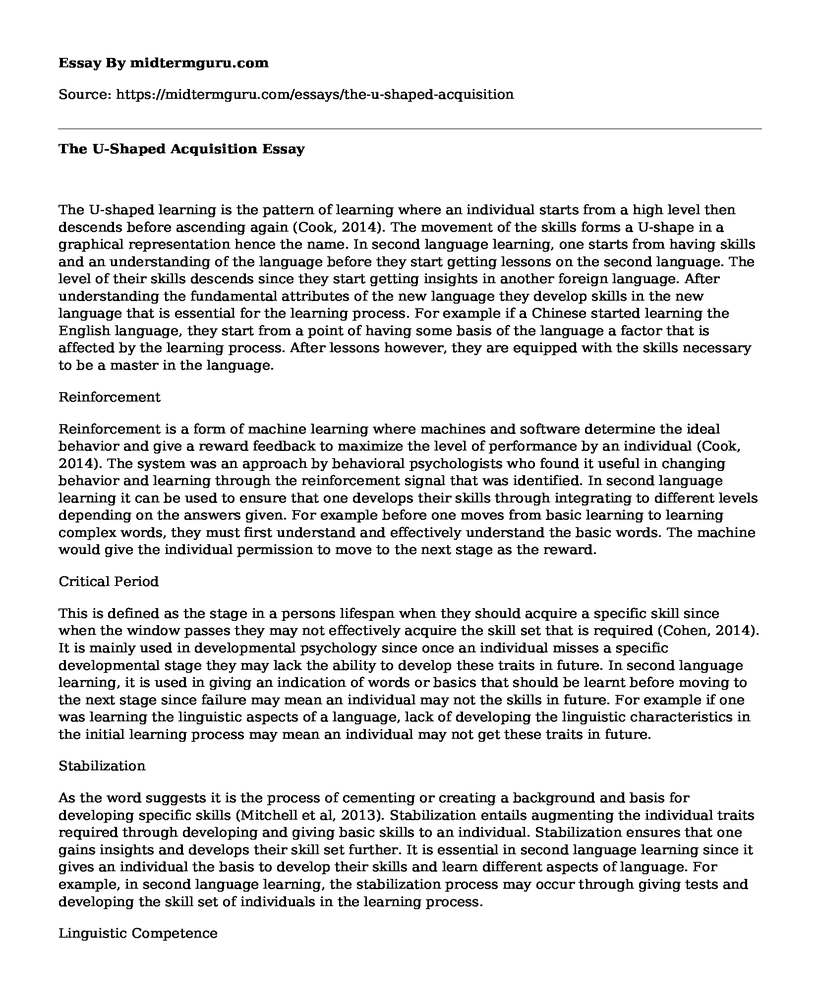The U-shaped learning is the pattern of learning where an individual starts from a high level then descends before ascending again (Cook, 2014). The movement of the skills forms a U-shape in a graphical representation hence the name. In second language learning, one starts from having skills and an understanding of the language before they start getting lessons on the second language. The level of their skills descends since they start getting insights in another foreign language. After understanding the fundamental attributes of the new language they develop skills in the new language that is essential for the learning process. For example if a Chinese started learning the English language, they start from a point of having some basis of the language a factor that is affected by the learning process. After lessons however, they are equipped with the skills necessary to be a master in the language.
Reinforcement
Reinforcement is a form of machine learning where machines and software determine the ideal behavior and give a reward feedback to maximize the level of performance by an individual (Cook, 2014). The system was an approach by behavioral psychologists who found it useful in changing behavior and learning through the reinforcement signal that was identified. In second language learning it can be used to ensure that one develops their skills through integrating to different levels depending on the answers given. For example before one moves from basic learning to learning complex words, they must first understand and effectively understand the basic words. The machine would give the individual permission to move to the next stage as the reward.
Critical Period
This is defined as the stage in a persons lifespan when they should acquire a specific skill since when the window passes they may not effectively acquire the skill set that is required (Cohen, 2014). It is mainly used in developmental psychology since once an individual misses a specific developmental stage they may lack the ability to develop these traits in future. In second language learning, it is used in giving an indication of words or basics that should be learnt before moving to the next stage since failure may mean an individual may not the skills in future. For example if one was learning the linguistic aspects of a language, lack of developing the linguistic characteristics in the initial learning process may mean an individual may not get these traits in future.
Stabilization
As the word suggests it is the process of cementing or creating a background and basis for developing specific skills (Mitchell et al, 2013). Stabilization entails augmenting the individual traits required through developing and giving basic skills to an individual. Stabilization ensures that one gains insights and develops their skill set further. It is essential in second language learning since it gives an individual the basis to develop their skills and learn different aspects of language. For example, in second language learning, the stabilization process may occur through giving tests and developing the skill set of individuals in the learning process.
Linguistic Competence
Linguistic competence Refers to the linguistic knowledge that is possessed by a native speaker of a language (Cohen, 2014). An individual who has been well versed with a specific language has traits that enable them to be conversant and have the underlying ability needed to be good in the language. Native speakers have the characteristics and traits that are required to master the linguistic forms and aspects of a language. For example if a German learns English language there are aspects on their linguistic forms that are still synonymous with Germans.
References
Cohen, A. D. (2014). Strategies in learning and using a second language. Routledge.
Cook, V. (2013). Second language learning and language teaching. Routledge.
Mitchell, R., Myles, F., & Marsden, E. (2013). Second language learning theories. Routledge.
Cite this page
The U-Shaped Acquisition. (2021, May 20). Retrieved from https://midtermguru.com/essays/the-u-shaped-acquisition
If you are the original author of this essay and no longer wish to have it published on the midtermguru.com website, please click below to request its removal:
- Relation of Meaningful Work to Important Outcomes in a Public University
- Use of English and Communication Factors in Hospitality in Kazakhstan
- Paper Example on Drugs And Substance Abuse Among Students
- Essay Sample on Impacts of Social Media on College and Career Goals
- 2-7 Year Olds: Preoperational Cognitive Development - Essay Sample
- English Language Learners With Disabilities: An Overview - Essay Sample
- Article Analysis Essay on "City of Broken Dreams"







